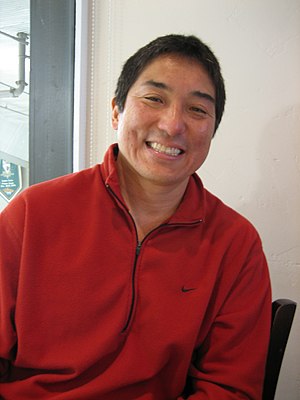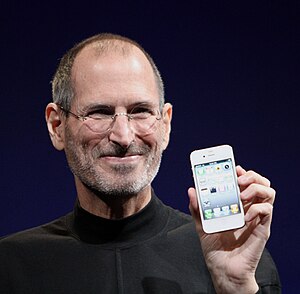| Image via Wikipedia |
Many people have explained what one can learn from Steve Jobs. But few, if any, of these people have been inside the tent and experienced first hand what it was like to work with him. I don't want any lessons to be lost or forgotten, so here is my list of the top 12 lessons that I learned from Steve Jobs.
| Image via CrunchBase |
1. Experts are clueless
Experts-journalists, analysts, consultants, bankers and gurus-can't "do" so they "advise." They can tell you what is wrong with your product, but they cannot make a great one. They can tell you how to sell something, but they cannot sell it themselves. They can tell you how to create great teams, but they only manage a secretary. … Hear what experts say, but don't always listen to them.
2. Customers cannot tell you what they need
… If you ask customers what they want, they will tell you, "Better, faster and cheaper"-that is, better sameness, not revolutionary change. They can only describe their desires in terms of what they are already using-around the time of the introduction of Macintosh, all people said they wanted was better, faster and cheaper MS-DOS machines. The richest vein for tech startups is creating the product that you want to use-that's what Steve and Woz did. | Image by Anirudh Koul via Flickr |
3. Jump to the next curve
Big wins happen when you go beyond better sameness. The best daisy-wheel printer companies were introducing new fonts in more sizes. Apple introduced the next curve: laser printing. Think of ice harvesters, ice factories and refrigerator companies. Ice 1.0, 2.0, and 3.0. Are you still harvesting ice during the winter from a frozen pond?
4. The biggest challenges beget best work.
I lived in fear that Steve would tell me that I, or my work, was garbage. In public. This fear was a big challenge. Competing with IBM and then Microsoft was a big challenge. … I, and Apple employees before me and after me, did their best work because we had to do our best work to meet the big challenges.
| Image via CrunchBase |
5. Design counts
… Mere mortals think that black is black, and that a trash can is a trash can. Steve was such a perfectionist-…and … he was right: some people care about design and many people at least sense it. Maybe not everyone, but the important ones.
6. You can't go wrong with big graphics and big fonts
Take a look at Steve's slides. The font is 60 points. There's usually one big screenshot or graphic. … So many people say that Steve was the world's greatest product introduction guy...don't you wonder why more people don't copy his style?
7. Changing your mind is a sign of intelligence
When Apple first shipped the iPhone there was no such thing as apps. Apps, Steve decreed, were a bad thing because you never know what they could be doing to your phone. … [Six] months later … Steve decided, or someone convinced Steve, that apps were the way to go-but of course. Duh! Apple came a long way in a short time from Safari web apps to "there's an app for that."
8. "Value" is different from "price"
… Price is not all that matters-what is important, at least to some people, is value. And value takes into account training, support and the intrinsic joy of using the best tool that's made. …
9. A players hire A+ players Actually, Steve believed that A players hire A players-that is people who are as good as they are. I refined this slightly-my theory is that A players hire people even better than themselves. It's clear, though, that B players hire C players so they can feel superior to them, and C players hire D players. If you start hiring B players, expect what Steve called "the bozo explosion" to happen in your organization.
10. Real CEOs demo
… [Why] is it that many CEOs call upon their vice-president of engineering to do a product demo? Maybe it's to show that there's a team effort in play. Maybe. It's more likely that the CEO doesn't understand what his/her company is making well enough to explain it. How pathetic is that?
| Image via Wikipedia |
11. Real CEOs ship
For all his perfectionism, Steve could ship. Maybe the product wasn't perfect every time, but it was almost always great enough to go. The lesson is that Steve wasn't tinkering for the sake of tinkering-he had a goal: shipping and achieving worldwide domination of existing markets or creation of new markets. …
12. Marketing boils down to providing unique value
Think of a 2 x 2 matrix. The vertical axis measures how your product differs from the competition. The horizontal axis measures the value of your product. Bottom right: valuable but not unique- you'll have to compete on price. Top left: unique but not valuable-you'll own a market that doesn't exist. Bottom left: not unique and not value-you're a bozo. Top right: unique and valuable-this is where you make margin, money, and history. …
Bonus: Some things need to be believed to be seen
When you are jumping curves, defying/ignoring the experts, facing off against big challenges, obsessing about design and focusing on unique value, you will need to convince people to believe in what you are doing in order to see your efforts come to fruition. … Not everyone will believe-that's okay. But the starting point of changing the world is changing a few minds. This is the greatest lesson of all that I learned from Steve.
***
Guy Kawasaki is the author of Enchantment: The Art of Changing Hearts, Minds, and Actions. He is also the co-founder of Alltop.com, an "online magazine rack" of popular topics on the web, and a founding partner at Garage Technology Ventures. Previously, he was the chief evangelist of Apple. Kawasaki is the author of nine other books including Reality Check, The Art of the Start, Rules for Revolutionaries, How to Drive Your Competition Crazy, Selling the Dream, and The Macintosh Way. Kawasaki has a BA from Stanford University and an MBA from UCLA as well as an honorary doctorate from Babson College.
| Cover via Amazon |
| Cover via Amazon |













No comments:
Post a Comment